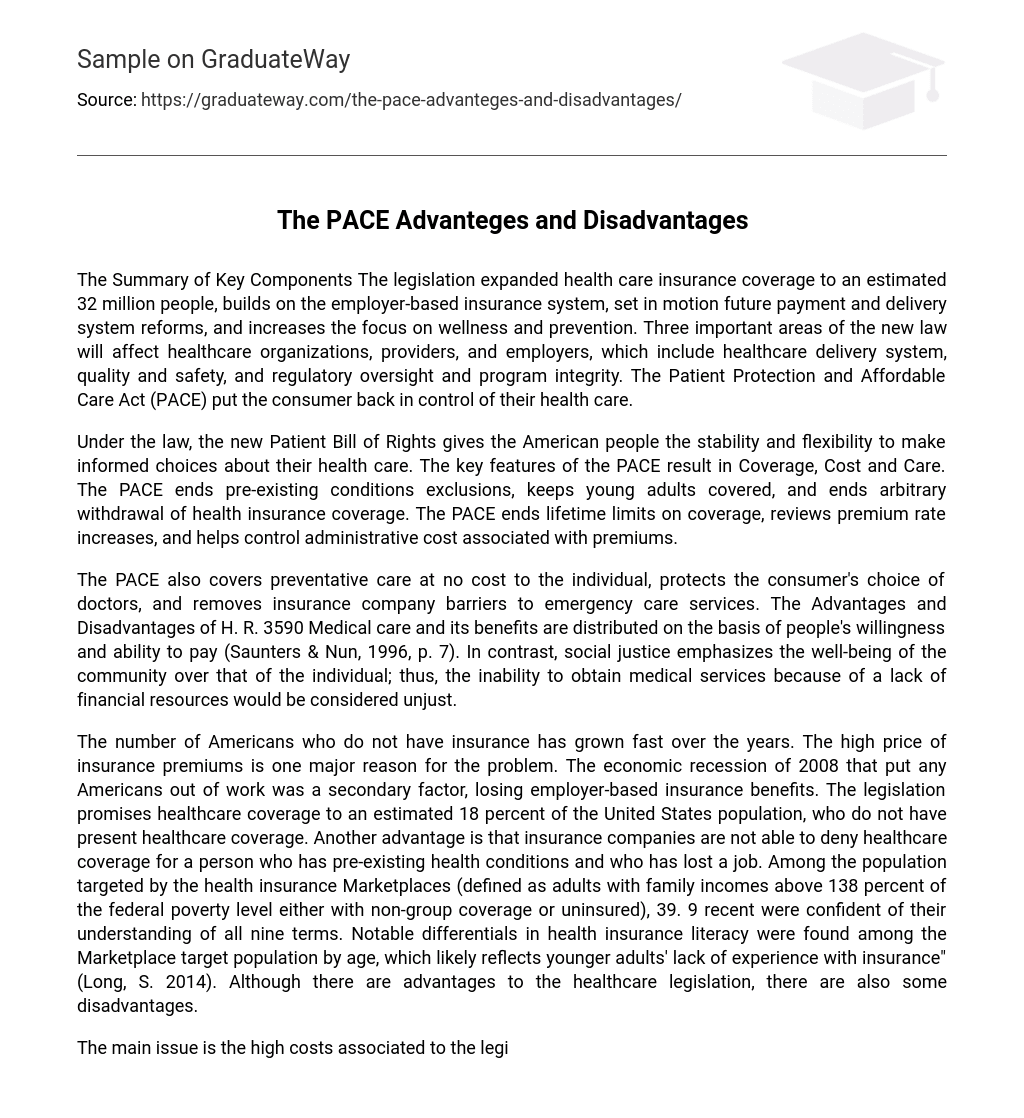The Summary of Key Components The legislation expanded health care insurance coverage to an estimated 32 million people, builds on the employer-based insurance system, set in motion future payment and delivery system reforms, and increases the focus on wellness and prevention. Three important areas of the new law will affect healthcare organizations, providers, and employers, which include healthcare delivery system, quality and safety, and regulatory oversight and program integrity. The Patient Protection and Affordable Care Act (PACE) put the consumer back in control of their health care.
Under the law, the new Patient Bill of Rights gives the American people the stability and flexibility to make informed choices about their health care. The key features of the PACE result in Coverage, Cost and Care. The PACE ends pre-existing conditions exclusions, keeps young adults covered, and ends arbitrary withdrawal of health insurance coverage. The PACE ends lifetime limits on coverage, reviews premium rate increases, and helps control administrative cost associated with premiums.
The PACE also covers preventative care at no cost to the individual, protects the consumer’s choice of doctors, and removes insurance company barriers to emergency care services. The Advantages and Disadvantages of H. R. 3590 Medical care and its benefits are distributed on the basis of people’s willingness and ability to pay (Saunters & Nun, 1996, p. 7). In contrast, social justice emphasizes the well-being of the community over that of the individual; thus, the inability to obtain medical services because of a lack of financial resources would be considered unjust.
The number of Americans who do not have insurance has grown fast over the years. The high price of insurance premiums is one major reason for the problem. The economic recession of 2008 that put any Americans out of work was a secondary factor, losing employer-based insurance benefits. The legislation promises healthcare coverage to an estimated 18 percent of the United States population, who do not have present healthcare coverage. Another advantage is that insurance companies are not able to deny healthcare coverage for a person who has pre-existing health conditions and who has lost a job. Among the population targeted by the health insurance Marketplaces (defined as adults with family incomes above 138 percent of the federal poverty level either with non-group coverage or uninsured), 39. 9 recent were confident of their understanding of all nine terms. Notable differentials in health insurance literacy were found among the Marketplace target population by age, which likely reflects younger adults’ lack of experience with insurance” (Long, S. 2014). Although there are advantages to the healthcare legislation, there are also some disadvantages.
The main issue is the high costs associated to the legislation. The government will need to raise funds to provide modern facilities to people. Some experts believe this will lead to increased taxes on businesses and high-income families. Those who filed taxes in 2014 ND did not have healthcare insurance through an employer-based program, or a healthcare exchange were faced with a tax-penalty. Some agreed the penalty cost less than the monthly premiums they would have paid. Still, this has not solved the problem of covering all people with healthcare insurance. However, most adults are relying on multiple sources of information, which suggests that multiple opportunities exist to reach them through broad education and outreach efforts. Further, these patterns may change over time as new sources of information become available” (Long, S. 2014). I believe this will continue to rive the costs of care as people without coverage continue to use the healthcare system. On the positive side, it may force more competition between the health insurance providers in the United States market and this will ultimately benefit the consumer and the healthcare industry.
Michael Tanner wrote an excellent article on the Patient Protection and Affordable Care Act (PACE). His paper asks if the PACE achieves its goals of significantly expanding health insurance coverage, while reducing costs and increasing the quality of care provided. An early examination and current and future projections suggests the PACE ill increase that number of Americans with health insurance but fall short of universal coverage. In addition, the PACE fails to control health care costs, and will cause higher cost for the government, many businesses, and individuals (Tanner, M. 2013). Conclusion In the United States the publicly financed Medicare and Medicaid coverage for certain disadvantaged groups, and the worker’s compensation program for those injured at work, are the type of health care insurance that are based on the social justice distribution principle. The United States’ access to affordable lath care services has been limited to many people suffering from preexisting health conditions. Prior to the H. R. 590 legislation, access was granted only to individuals who have health insurance through their employers, or were covered under a government health care program. Those left in the middle most times found private health insurance unaffordable on limited income resources. In 1934, President Franklin D. Roosevelt enacted the Medicare and Medicaid system to provide health care to the population’s elderly and disabled. Since then, health care in the United States has continued to undergo periodic changes mainly n response to concerns with cost, access, and quality.





